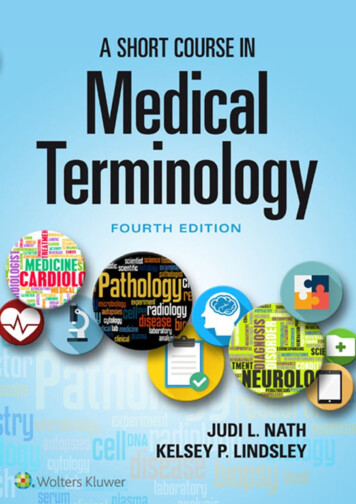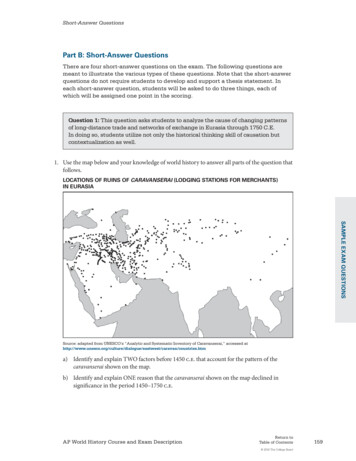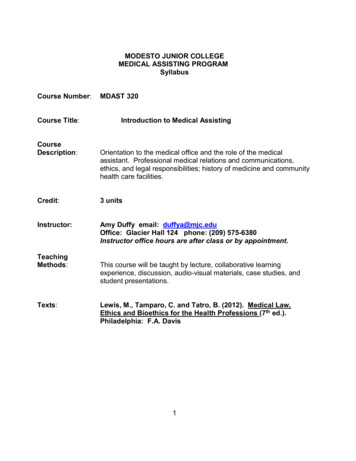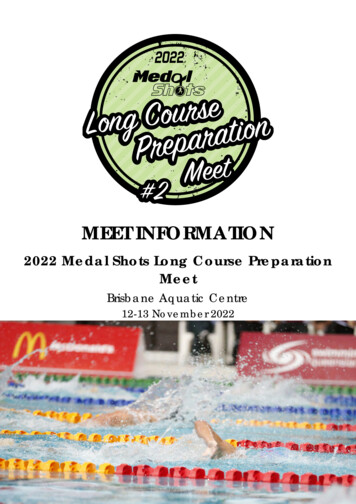
Transcription
Acquisitions Editor: Jonathan JoyceDevelopment Editor: Amy MillholenEditorial Coordinator: John LarkinEditorial Assistant: Tish RogersMarketing Manager: Leah ThomsonProduction Project Manager: David SaltzbergDesign Coordinator: Holly Reid McLaughlinManufacturing Coordinator: Margie OrzechPrepress Vendor: S4Carlisle Publishing ServicesFourth editionCopyright 2019 Wolters Kluwer.Copyright 2012, 2009, 2003 Wolters Kluwer Health/Lippincott Williams & Wilkins. All rightsreserved. This book is protected by copyright. No part of this book may be reproduced or transmitted inany form or by any means, including as photocopies or scanned-in or other electronic copies, or utilizedby any information storage and retrieval system without written permission from the copyright owner,except for brief quotations embodied in critical articles and reviews. Materials appearing in this bookprepared by individuals as part of their official duties as U.S. government employees are not covered bythe above-mentioned copyright. To request permission, please contact Wolters Kluwer at TwoCommerce Square, 2001 Market Street, Philadelphia, PA 19103, via email at permissions@lww.com, orvia our website at lww.com (products and services).9 8 7 6 5 4 3 2 1Printed in ChinaLibrary of Congress Cataloging-in-Publication DataNames: Nath, Judi Lindsley, author.Title: A short course in medical terminology / Judi L. Nath, Ph.D., LourdesUniversity, Kelsey P. Lindsley, R.Ph., Pharm.D.Description: Fourth edition. Philadelphia: Wolters Kluwer Health, [2019] Revision of: Short course in medical terminology / C. Edward Collins, Textand Academic Authors Association, St. Petersburg, Florida. Includesindex.Identifiers: LCCN 2017044655 eISBN 9781496351500Subjects: LCSH: Medicine—Terminology. Medical sciences—Terminology. BISAC: MEDICAL / Dictionaries & Terminology.Classification: LCC R123 .C594 2019 DDC 610.1/4—dc23 LC record available athttps://lccn.loc.gov/2017044655This work is provided “as is,” and the publisher disclaims any and all warranties, express or implied,including any warranties as to accuracy, comprehensiveness, or currency of the content of this work.This work is no substitute for individual patient assessment based upon healthcare professionals’examination of each patient and consideration of, among other things, age, weight, gender, current orprior medical conditions, medication history, laboratory data, and other factors unique to the patient.The publisher does not provide medical advice or guidance and this work is merely a reference tool.Healthcare professionals, and not the publisher, are solely responsible for the use of this work includingall medical judgments and for any resulting diagnosis and treatments.Given continuous, rapid advances in medical science and health information, independent professionalverification of medical diagnoses, indications, appropriate pharmaceutical selections and dosages, andtreatment options should be made, and healthcare professionals should consult a variety of sources.When prescribing medication, healthcare professionals are advised to consult the product information
sheet (the manufacturer’s package insert) accompanying each drug to verify, among other things,conditions of use, warnings and side effects and identify any changes in dosage schedule orcontraindications, particularly if the medication to be administered is new, infrequently used or has anarrow therapeutic range. To the maximum extent permitted under applicable law, no responsibility isassumed by the publisher for any injury and/or damage to persons or property, as a matter of productsliability, negligence law or otherwise, or from any reference to or use by any person of this work.LWW.com
This book is dedicatedto my students and colleaguesat Lourdes University,who continue to provide inspirationand support. Thank you!-JUDI L. NATHThis book is dedicated to my parents,who have always loved and supported meand who accepted dishwashingin exchange for rentwhile I was working on this book.-KELSEY P. LINDSLEY
This new edition builds on the foundation established in the previous threeeditions. The reader will find the writing style of this edition easy to follow,with special focus given to ensuring that each page is user friendly andaccessible to all levels of learning. As educators, we wanted to be sure thatstudents found the content manageable, interesting, and understandable.APPROACH AND CONTENT ORGANIZATIONThis section outlines the global changes that were made throughout the entiretextbook as well as the chapter-by-chapter changes. We begin with thosechanges across the chapters.Global Changes The narrative has been modernized to make the text more user-friendlyand approachable for students. The chapter headings have been standardized to appear in a consistentorder so material is presented utilizing a consistent style. The topics in the study table were also standardized so that the orderfollows a predictable sequence. Study Tables may contain terms that are not in the narrative; however,all bold-faced terms in the narrative are found in the Study Tables. Thebook would become unwieldy with text if the terms in the tables werealso in the narrative. We have selected the most relevant terms forinclusion in the tables. The end-of-chapter exercises have been standardized, so that fromchapter-to-chapter exercises are presented in the same order. Chapter 15 The Special Senses of Sight and Hearing has been movedto appear directly after Chapter 7 The Nervous System. This order
makes sense from a functional perspective and matches other currentanatomy and physiology books. Rearranging the topics in this manneralso allows the book to be used in tandem with an anatomy andphysiology course. All terminology has been updated per current medical usage.Stedman’s Medical Dictionary, Terminologia Anatomica, TerminologiaHistologica, Terminologia Embryologica, and leading medical journalswere used to standardize the medical terms, so that they are currentand match terms used in common practice. Pronunciations match Stedman’s Medical Dictionary. AlthoughStedman’s Medical Dictionary uses a diacritic format whereby signsand symbols are used with letters to indicate pronunciations, thepronunciations given in this book are those used for oralcommunication so we used phonetic pronunciations. Appendixes A through E have been updated so the information is themost current, nationally recognized. The artwork has been updated and revised extensively to be accurateand contemporary. We also improved the text–art integration toenhance the student learning experience. Citations from image captions have been removed, so that the reader isnot distracted from the image and its learning opportunity. Unnecessarily long table titles were shortened to make table titleseasier for students to read and understand. More photos were added for realism and interest. The phrase “word elements” was changed to “word parts” to avoidambiguities when some word parts served double functions, as insometimes a word part was a root and a prefix. This change alsoenabled consistency. Quick Checks were updated to provide benchmarks within the chapterfor students to assess retention of information. Sidebar Information was updated with interesting facts. It is alsodesigned so that it is a “pointable feature” and there is at least one perchapter. Material from Crossword Puzzles and Chapter Quizzes has beenfolded into the End-of-Chapter Exercises.
Revised Table of ContentsChapter 1 Analyzing Medical TermsChapter 2 Common Prefixes and SuffixesChapter 3 Organization of the BodyChapter 4 The Integumentary SystemChapter 5 The Skeletal SystemChapter 6 The Muscular SystemChapter 7 The Nervous SystemChapter 8 The Special Sense of Sight and HearingChapter 9 The Endocrine SystemChapter 10 The Cardiovascular SystemChapter 11 The Lymphatic System and ImmunityChapter 12 The Respiratory SystemChapter 13 The Digestive SystemChapter 14 The Urinary SystemChapter 15 The Reproductive SystemBasic Chapter Outline Template1. Learning Outcomes (changed from learning objectives)2. Introduction3. Word Parts Related to the XXX System4. Structure and Function5. Quick Check (at lease one per chapter)6. Disorders Related to the XXX System7. Diagnostic Tests, Treatments, and Surgical Procedures8. Practice and Practitioners9. The XXX System Abbreviation Table10. Sidebar (at least one per chapter)11. The XXX System Study Table (alphabetized within subheadings)
Structure and Function Disorders Diagnostic Tests, Treatments, and Surgical Procedures Practice and Practitioners12. End-of-Chapter Exercises—not all exercises may be present, but theorder of exercises is maintained Exercise X-X Labeling Exercise X-X Word Parts Exercise X-X Word Building Exercise X-X Matching Exercise X-X Multiple Choice Exercise X-X Fill in the Blank Exercise X-X Abbreviations Exercise X-X Spelling Exercise X-X Case StudyChapter-by-Chapter ChangesChapter 1 Analyzing Medical Terms New Art: Figure 1-1 New Word Parts: non New Terms: etymology and language sense Deleted Word Part: cleric Added new Quick CheckChapter 2 Common Prefixes and Suffixes Changed chapter title from Common Suffixes and Prefixes to CommonPrefixes and Suffixes and changed the order of presentation in thechapter so that prefixes are introduced before suffixes and to match thenew chapter title New Word Parts: a-, an-, anti-, -cele, -cyte, de-, dis-, -eal, -edema, emesis, -emia, -ism, -lith, -lysis, -oid, -opsy, -pathy, -phobia, -plasia, poesis, -rrhea, -sclerosis, -stasis, -stenosis, -stomy, tic, and–tome
Added new Quick CheckChapter 3 Organization of the Body Changed chapter title from The Body’s Organization to Organizationof the Body New Art: Figures 3-1, 3-2, 3-3, 3-4, 3-5, 3-6, and 3-7 New Word Parts: gastr/o and thorac/o New Terms: abdominal cavity, anatomy, caudal, cephalad, cervix,coccyx, coronal plane, cranial, lumbus, pelvic cavity, physiology,sacrum, thorax, and ventral Deleted Terms: anatomical terms of location, dorsal cavity, andmidsagittal Added new Quick CheckChapter 4 The Integumentary System New Art: Figures 4-1, 4-6, and 4-10 New Word Parts: adipo- and -oma New Terms: arrector pili muscles, benign, bulla, carcinoma, decubitusulcers, edema, erythematous, fissure, hypodermis, integumentarysystem, malignant, plaque, pruritic, prurigo, and whealChapter 5 The Skeletal System New Art: Figures 5-1, 5-2, 5-8, 5-9, 5-10, 5-11, 5-12, 5-13, 5-14, andnew images for Table 5-3 New Terms: appendicular skeleton, axial skeleton, carpal bones, closedfracture, compound fracture, compact bone, cranial suture, cranium,epiphyseal plate, hip bone, joint, kinesiologists, lateral malleolus,ligaments, tendons, medial malleolus, neoplasms, occupationaltherapists, open fracture, osseous tissue, physical therapists, simplefracture, spongy bone, sternum, synovial fluid, synovial joint, tarsalbones, thoracic cage, and vertebral column New Abbreviations: MRI and NSAID Deleted Abbreviations: CTS and LE Deleted Terms: chondrodynia and dactylomegaly Deleted Word Parts: cheir/o and -desis
Chapter 6 The Muscular System Deleted Table 6-2 because it is in Chapter 5 Reorganized comparative art in Figure 6-1 Added new Sidebar on dysphagia and dysphasia New Art: Figures 6-2 and 6-5 New Abbreviations: ALS, FX, MD, NSAID, and PT Deleted Abbreviations: CTD, DMD, and DTR New Terms: agonist, Duchenne dystrophy, dysphagia, fascicle, musclefibers, paresis, skeletal muscle, and striated muscle Deleted Terms: myoparesis, tenalgia, tenontoplasty, tendoplasty, andtenoplastyChapter 7 The Nervous System New Art: Figures 7-1, 7-3, 7-5, 7-6, 7-8, and Labeling Exercise 7-1 New Abbreviations: AD, CSF, CT, DM, MRI, and PD Deleted Abbreviations: IQ, OBS, PERRLA, SAD, and TENS New Terms: demyelination, lesion, seizure, sympathetic nervoussystem, and parasympathetic nervous system Term Changes: changed brain stem to brainstem per TerminologiaAnatomica, changed petit mal seizure to absence seizure Added a new sidebar on the difference between psychiatrist andpsychologist Deleted Terms: subsystemsChapter 8 The Special Senses of Sight and Hearing New Art: Figures 8-2, 8-3, 8-4, 8-8, 8-9, and Labeling Exercise 8-1 New Abbreviations: EOM, LASIK, and O.D. Deleted Abbreviations: ASL, dB, ECCE, ERG, ICCE, and PVD New Terms: auditory tube, cones, external acoustic meatus, deaf,extra-ocular muscles, eyebrows, eyelashes, eyelids, lacrimal ducts,lacrimal fluid, lacrimal glands, lacrimal sac, laser-assisted in situkeratomileusis (LASIK), lateral angle of eye, medial angle of eye,orbit, refraction, rods, and scleral buckle
Term Changes: inner canthus changed to medial angle of the eye, outercanthus changed to lateral angle of the eye, outer ear changed toexternal ear, inner ear changed to internal ear, external auditory canalchanged to external acoustic meatus, and eustachian tube changed toauditory tube per Terminologia Anatomica Deleted Word Parts: dacryocyst/o, irit/o, and phak/oChapter 9 The Endocrine System New Art: Figure 9-1, 9-3, 9-4, 9-5, 9-6, 9-7, and Labeling Exercise 9-1 New Abbreviations: T3, T4, CT, PTH, and GTT Deleted Abbreviations: BS, IDDM, and NIDDM New Terms: corticosteroids, fasting blood sugar (FBS), goiter,exophthalmos, hypothalamus, pineal gland, glands, polydipsia,polyuria, and thyroid-stimulating hormone (TSH)Chapter 10 The Cardiovascular System New Art: Figures 10-5, 10-6, and 10-7 Deleted Abbreviations: CP, ICU, Rh , and Rh– New Terms: apex, atrioventricular valves, coronary artery disease,embolus, heartbeat, pulmonary circuit, and systemic circuit Deleted Terms: arteritis, cardiodynia, cardiomalacia, pericardial sac,and phagocyteChapter 11 The Lymphatic System and Immunity New Art: Figures 11-1, 11-2, 11-3, 11-4, and Labeling Exercise 11-1 New Abbreviations: EBV Deleted Abbreviations: CBC, HLA, and RIA Deleted Figure: former Figure 10-1 New Terms: allergy, autoimmune disease, elephantiasis, immunization,lymph node, lymphography, pathogen, systemic lupus erythematosus,vaccination, and vaccineChapter 12 The Respiratory System Changed The Nose heading to The Nose, Nasal Cavity, and ParanasalSinuses; changed The Pharynx heading to The Pharynx and Tonsils;added new section on The Diaphragm
Added new Sidebar on the common cold viruses New Word Part: adeno New Art: Figures 12-1, 12-3, 12-4, 12-6, 12-7, 12-8, 12-9, andLabeling Exercise 12-1 New Abbreviations: BP, c/o, F, ICU, P, T and A, URI, VC, and WBC Deleted Abbreviations: T&A changed to T and A Deleted Figure: former Figure 11-4 New Table 12-2 Pulmonary Volumes and Capacities New Terms: cyanosis, lungs, nasal cavity, nasal septum, nose,paranasal sinuses, tonsils, and ventilationChapter 13 The Digestive System New Art: Figures 13-1, 13-2, 13-3, 13-5, and Labeling Exercise 13-1 Changed common bile duct to bile duct per Terminologia Anatomica New Abbreviations: NG and UGIS Deleted Abbreviations: GB, GBS NGT, and UGI New Terms: absorption, bile duct, digestion, elimination,esophagogastroduodenoscopy, irritable bowel syndrome, and loweresophageal sphincter Deleted Terms: common bile duct and fundusChapter 14 The Urinary System New Art: Figures 14-1, 14-3, and Labeling Exercise 14-1 Changed perirenal fat to perinephric fat or pararenal fat body perTerminologia Anatomica Added information on the nephron, glomerulus, and glomerularfiltration rate New Abbreviations: ARF and CRF Deleted Abbreviations: BPH and PSA New Terms: antibiotic, calyx, kidney transplant, micturition,nephropexy, renal corpuscle, renal cortex, renal medulla, renal pelvis,and renal tubuleChapter 15 The Reproductive System
New Art: Figures 15-1, 15-4, 15-6, 15-7, and Labeling Exercise 15-1 New Sidebar on meiosis and mitosis Changed amniotic sac to amnion per Terminologia Anatomica Changed spermatozoon and spermatozoa to sperm per TerminologiaHistologica New Abbreviations: A, C-section, EDC, EDD, G, HIV, P, Pap smear,STD, and STI Deleted Abbreviations: DUF, HRT, HSG, IUD, PMS, TAH, and VD New Terms: abortus, amnion, amniotic fluid, amniotic sac, clitoris,glans, foreskin, fundus, labium majus, labium minus, umbilical cord,urologist, and vulvaOTHER RESOURCESOnline ancillary materials complement the text and provide additional supportfor student learning.Student Resources: Question Bank, with a variety of exercise types to reinforce chaptermaterial Educational Games, such as crossword puzzles, hangman, and wordbuilding challenges Audio Glossary Flash Cards, including Flash Card Generator Chapter Quizzes Final ExamInstructor Resources: PowerPoint slides and Lesson Plans include useful information tofacilitate presentation of material by instructors. Test Generator, with more than 500 questions to test students’knowledge of terms, their meanings, and abbreviations. Handouts include additional puzzles and games for additional studentpractice.
Welcome to the field of medical terminology. This workbook-textbook iswritten to teach the language of medicine in an engaging and meaningful way.It is written to represent the real world so that you can move seamlessly fromthe classroom to actual practice. The approach is based on research thatdemonstrates how students learn best. To that end, we used a three-prongedapproach: (1) immersion—the terms are presented in context; (2) chunking—the material is given in manageable units; and (3) practice—exercises thatallow you to check your knowledge. Learning word parts is also an essentialcomponent of learning the terms. If you learn the tables of word parts, youwill be well on your way to knowing medical terms you have neverencountered, because you can figure out the terms by breaking them into theircomponent word parts. This will be quite useful, because not every word youwill encounter in your careers is found in this book, but you will be equippedwith the knowledge to understand their meaning. We also encourage you topay special attention to the analysis sections in the Study Tables, as theseprovide interesting, foundational information for forming medical terms.While learning medical terminology, you will also learn some basicanatomy (body structures), physiology (body functions), and pathology (bodydiseases). Because medical terms describe the human body in health and indisease, attaining an elementary understanding of these topics will help youretain a working memory of medical language.Learning medical terms can be easy if you approach the subject from aproper perspective. Begin by telling yourself that medical terms do not makeup a separate language. Medical terms are simply words that you can add toyour vocabulary. As with all words, medical words are meant to conveyinformation.As you enter a medical profession, you will be communicating with othermedical professionals and with patients. Therefore, your job will include
choosing words and sentence structures that convey accurate information andreflect a professional attitude. That is to say, both your communication skillsand your attitude toward patients are very important. As you are about todiscover, learning medical terminology can be easy at times and challengingat others. However, if you use the textbook and its ancillaries to their fullest,you will be well on your way to mastering medical terminology.Judi L. Nath, Ph.D.ProfessorLourdes UniversitySylvania, OhioKelsey P. Lindsley, R.Ph., Pharm.D.Pharmacist, PreceptorClinical PractitionerPort Clinton, Ohio
LEARNING OUTCOMESUpon completion of this chapter, you should be able to: Recognize prefixes. Recognize suffixes. Define all of the prefixes and suffixes presented in this chapter. Analyze and define new terms introduced in this chapter. Pronounce, define, and spell each term introduced in this chapter.A Short Course in Medical Terminology, Fourth Edition, was developed toprovide an easy, efficient, and effective way to learn medical terminology.This User’s Guide introduces the features of the book that help the learningexperience.A logical organization guides students through the basics of medicalterminology, word parts, and word analysis.
Chapters 1 and 2 introduce the basics of word building and set thefoundation for learning terms.Chapters 3–15 offer an overview of each body system and introduce termsthat identify the structure and function of that system along with terms thatname system disorders, diagnostic tests, treatments, surgical procedures,practice, and practitioners.Each chapter opens with a statement of learning outcomes. These aremeasurable educational aims and objectives that indicate what you should beable to do after completing the chapter.An introduction and a tabular presentation of Word Parts related to a specificbody system are presented next.
Word Parts Exercises offer you an opportunity to quickly review the wordparts before moving on to new material.Structure and Function sections with full-color illustrations help you learn
basic anatomy and physiology using tight text–art integration.
Quick Checks exercises help reinforce your knowledge of term parts before
studying disorders related to the body systems.All body system chapters include an Abbreviations Table, which listscommon abbreviations and their meanings used in the chapter.Sidebars appear throughout to highlight interesting facts about medical termsand words in general.All body system chapters include a Study Table summarizing terms forreinforcement of the material in an easy-to-reference format. Some terms inthe table are not found in the running narrative, but are important to include,or the terms are used in the end-of-chapter case study.
End-of- Chapter Exercises and a Case Study close out each chapter tomaximize learning. Exercises include figure labeling, word building,matching, multiple choice, fill-in-the-blank, short answer, true/false, andspelling. The Case Study provides real world application of medical termsand gives you an opportunity to interact with the chapter material as youwould in a clinical setting.
The authors and publisher would like to thank the following individuals whohelped to review this textbook:Rhonda AndersonInstructorPhlebotomyGreenville Technical CollegeGreenville, South CarolinaMarianne DemskyInstructorHuman ResourcesJohns Hopkins HospitalBaltimore, MarylandPatricia KetchamDirector of Nursing LaboratoriesSchool of NursingOakland UniversityRochester, MichiganAmie MayhallInstructorMedical Office CareersOlney Central College
Olney, IllinoisAshita PatelInstructorMedical AssistingWake Technical Community CollegeRaleigh, North CarolinaLona SandonAssistant ProfessorClinical NutritionUT Southwestern Medical CenterDallas, TexasKaren K. SmithAssistant ProfessorHealth Information Management ProgramUniversity of Arkansas for Medical Sciences, College of Health ProfessionsLittle Rock, ArkansasJonette Talbott RN, MSN, NP-CProfessor and Program DirectorPractical NursingSouthside VA Community CollegeAlberta, VirginaMargaret TiemannInstructor—RetiredHealth Information TechnologySt. Charles Community CollegeCottleville, MissouriRafael TolentinoChief Academic Officer
Nursing & Health AlliedHomestead Schools, Inc.Torrance, California
With sincere gratitude, I wish to acknowledge all the hard work done by themembers of the editorial staff of Wolters Kluwer. Writing and publishing atextbook requires more than putting fingers to the keyboard. The printed bookrepresents the work of many dedicated individuals, without whom this projectcould not be completed. To begin, thanks to exceptional editor, JonathanJoyce, for bringing this book to my attention and encouraging me to work onit. To editorial coordinator, John Larkin, thank you for being my point person;you were always quick to respond and helpful with your responses. Specialappreciation is extended to developmental editor, Amy Millholen, who hasbeen at my side for several titles, providing expert advice and direction. Around of applause goes to the Wolters Kluwer sales and marketing team ledby marketing manager, Leah Thomson.We also offer posthumous heartfelt indebtedness to C. Edward Collins, theoriginal author of this book. Through three editions you were the pen behindthe pages; may this work be a testament to your legacy.
1 Analyzing Medical Terms2 Common Prefixes and Suffixes3 Organization of the Body4 The Integumentary System5 The Skeletal System6 The Muscular System7 The Nervous System8 The Special Senses of Sight and Hearing9 The Endocrine System10 The Cardiovascular System11 The Lymphatic System and Immunity12 The Respiratory System13 The Digestive System14 The Urinary System15 The Reproductive SystemAPPENDICESA AnswersB Glossary of Word Parts with MeaningsC Glossary of AbbreviationsD Error-Prone Abbreviations, Symbols, and Dose DesignationsE Top 100 Prescribed Medications
Index
LEARNING OUTCOMESUpon completion of this chapter, you should be able to: Discuss the purpose of medical terminology. Recognize each of the four word parts of medical terms: prefixes, roots,suffixes, and combining forms. Define the commonly used prefixes, roots, and suffixes introduced in thischapter. Divide medical terms into word parts. Understand how word parts are put together to make medical terms. Recognize the importance of proper spelling, pronunciation, and use ofmedical terms.INTRODUCTIONThere are many ways and various books to help you learn medicalterminology. This book is intended for a short course in medical terminologyand focuses on medical terms, their definitions, and brief exercises to helpyou quickly gauge your understanding. That means this book can be workedthrough in as little as 8 weeks. Our goal is to give you all the basics you willneed to be successful in your career, while allowing you to have a little funlearning. Every word in the medical field is not found in this book, but all the
Latin and Greek word parts are found here. These word parts can becombined to make thousands of medical terms, and understanding the basicword parts is the first step toward understanding complete words. While it ispossible to memorize the definitions of individual medical words,understanding just the parts that make up the medical word is easier and fasterthan learning every word because there are fewer word parts than completewords. In fact, approached the right way, medical terminology may be theeasiest subject in your program. Learning it takes a bit of thought and an openmind; but it need not involve sweating or ripping out your hair in frustration.Why is medical terminology important? Can’t medical professionals justuse simple words like “gut” and “cut”? Unfortunately, these aren’t alwaysspecific enough. Gut can refer to the stomach, small intestine, large intestine,or any part of your digestive system. If you have pain in one of these areas,you would want to be able to easily identify a single area and have all medicalprofessionals recognize that specific area. The term “cut” could mean just anincision, or in other cases it could mean cutting off a body part. For example,“She cut her hand” indicates an incision, but “Cut the hand distal to the wrist”could mean an amputation. Luckily medical terminology allows us tospecifically identify places in the body and even what type of cut it is withwords (see Figure 1-1).
FIGURE 1-1 This cartoon demonstrates the value of standardized medicalterms.The foundation of medical terminology is rooted in learning the four basicword parts: prefixes, roots, suffixes, and combining forms. You’ll learn howto distinguish among these word parts in order to combine them intomeaningful medical terms.First, let’s examine some medical term characteristics. Most medicalterms are derived from Latin and Greek languages. While this may makethem seem “foreign,” 75% of all English words are derived from Latin andGreek. When you look up a term in the dictionary, its etymology, or wordorigin, is usually given along with its definition. For example, dementia is animpairment of cognitive function marked by memory loss. It comes from the
Latin word, demens, which means “out of one’s mind.”ACQUIRING AND USING LANGUAGE SENSEAccurate communication in any specialty field depends on language sense.Language sense is knowing what words mean and forecasting the effectstheir combinations will produce. This is a two-part definition. First, we haveto understand what the word we’re using means. Second, we have to trust thatthe person listening to what we’re saying also understands the meaning of thewords that we’re using. While this is important in everyday language, it isespecially important with medical terminology where misunderstanding canhave drastic effects on patients.Who decides what the “correct” anatomic term is? A system of anatomic naming known asTerminologia Anatomica is considered the international standard for terminology that deals withhuman anatomy. It was created by the Federative Committee on Anatomical Terminology and firstpublished in 1998. It is essentially an anatomy dictionary that gives the Latin base of the wordalong with the accepted English term. It has standardized anatomy-related terminology and is agreat resource.What does language sense have to do with learning medical terms? First,words have parts, and examining those parts forces the learner to see and hearwords in a new way. That is, the person becomes conscious of words aswords. You’ll have to think about each part of the word and then put it alltogether to understand how the parts make up the whole. Second, the abilityto use words well involves learning the phonetic and grammatical codes thatmake complex communication possible. This means using properpronunciation and using medical terminology correctly in a sentence. Medicalterminology is probably one of your first
the above-mentioned copyright. To request permission, please contact Wolters Kluwer at Two Commerce Square, 2001 Market Street, Philadelphia, PA 19103, via email at permissions@lww.com, or via our website at lww.com (products and services). 9 8 7 6 5 4 3 2 1 Printed in China Library of Congress Cataloging-in-Publication Data











